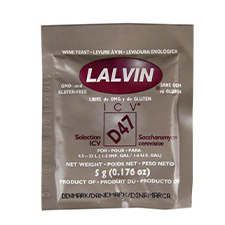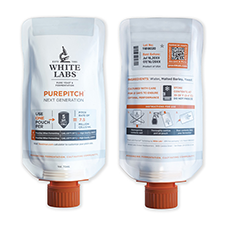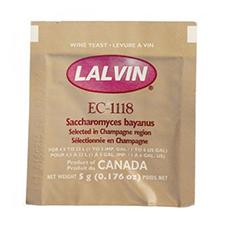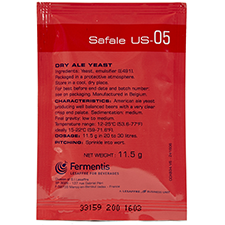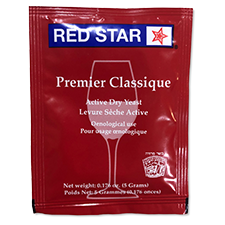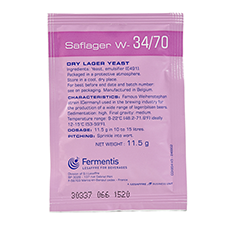How to Select Yeast for Beer and Winemaking
Posted by Matteo Lahm on 11th Jun 2024
Yeasts are not the same. There are many choices and there is a good reason for it: each has its own special style. Yeast makes beer and wine, not us, so it is important to get the right one for the job. Yeast strains are calibrated for different fermentation conditions and different ingredients. They vary for alcohol tolerances, flavors and aromas, temperatures and even fermentation speed. There are beer yeasts for beer, wine yeasts for wine and bread yeasts for neither. Choosing the right strain for your beer and winemaking needs is a cornerstone of your batch’s foundation. Choose poorly and the house will fall.
So how do you go about choosing? What specific information should you consider? In this article we will break down all the various factors of proper yeast selection to help you cut through the noise and get to the facts.
1. Yeast Strain: The strain of yeast you select is a fundamental decision that should be carefully matched with the type of beer or wine you're aiming to produce. This choice can significantly influence the flavor, aroma, and overall character of your final product.
For instance, if you're brewing an ale, a strain like the American Ale yeast is an excellent choice. This particular strain is known for its ability to produce a variety of American style ales effectively. It provides a clean, well-balanced and crisp finish that allows the malt and hop flavors to shine through, making it a perfect fit for ales.
On the other hand, if you're venturing into the world of winemaking, the choice of yeast strain becomes equally important. A strain like Lalvin ICV D-47, for example, is a popular choice for enhancing the fruity characteristics of white wines. This yeast strain is known for its ability to produce full-bodied, complex fruit wines and whites. It helps to accentuate the fresh fruit profile while adding subtle hints of citrus. It also contributes to the mouthfeel, providing a rich, creamy texture that can elevate the overall wine experience. Lalvin RC-212 is a go to for full-bodied reds.
In essence, the yeast strain is not just a fermenting agent, but a flavor developer that can bring out the best characteristics of your chosen ingredients. Therefore, understanding the unique properties of each yeast strain and how they align with your brewing or winemaking goals is crucial in creating a beverage that meets your desired taste profile.
2. Flavor Profile: The role of yeast in shaping the flavor profile of your brew or wine cannot be overstated. It's the silent maestro conducting a symphony of flavors, creating a unique harmony that defines your final product.
Let's say you're a beer enthusiast aiming to craft a brew that sings with fruity and spicy notes. In this case, the Belgian Ardennes yeast could be your ideal partner. This yeast strain is known for its ability to produce a variety of Belgian-style beers with a wide range of flavors and aromas. It can create a melody of fruity notes, such as pear and orange, and spicy notes, such as clove and coriander, that dance on the palate. The result? A beer that's a veritable fruit and spice bazaar, delighting the senses with every sip.
On the other hand, if you're a winemaker seeking to create a full-bodied red wine with robust flavors, the Red Star Premier Classique yeast should be on your radar. This yeast strain is a real powerhouse, known for its ability to ferment a wide range of red wines. It's particularly adept at enhancing the natural flavors of the grapes, resulting in wines with deep, rich flavors and aromas. It can help to highlight dark fruit flavors like plum and cherry, add complexity with notes of earth and spice, and provide a solid structure that can stand up to aging. The result is a red wine that's as bold and complex as a Shakespearean tragedy, captivating the palate from the first sip to the last.
In essence, the yeast you choose can be the difference between a good brew or wine and a great one. By understanding the flavor contributions of different yeast strains and how they are designed for different styles of beer and wine, you can tailor your selection to your desired flavor profile, resulting in a brew or wine that's truly a reflection of your taste and craftsmanship.
3. Temperature Tolerance: The environment in which you're fermenting is a critical factor in yeast performance, much like how a plant's growth is influenced by its surrounding climate. Yeasts, like all living organisms, have optimal temperature ranges where they perform their best.
Let's take lager yeasts as an example. These are the cool cats of the yeast world, thriving in chillier temperatures. A strain like Saflager W-34/70 is a prime example. It prefers to work in cooler conditions, typically between 48-59 degrees Fahrenheit (9-15 degrees Celsius). This preference for the cold allows it to produce the clean, crisp flavors that are the hallmarks of lagers.
On the flip side, ale yeasts are the sun-lovers of the yeast family. They prefer warmer conditions, usually between 59-77 degrees Fahrenheit (15-25 degrees Celsius). This warmth-loving nature allows them to ferment at a faster rate, producing the rich, complex flavors characteristic of ales.
Now, let's talk about winemaking. If your cellar tends to be on the warmer side, you'll need a yeast that can handle the heat and still perform well. Enter Lalvin EC-1118. This yeast strain is a real trooper, known for its ability to ferment effectively in a wide temperature range, from 50-86 degrees Fahrenheit (10-30 degrees Celsius). Its heat tolerance, combined with its high alcohol tolerance, makes it a popular choice for a variety of wines, especially when fermenting in warmer conditions.
In essence, understanding the temperature tolerance of yeast is akin to knowing the preferred climate of a plant you're trying to grow. By matching the yeast to the conditions you have, you can ensure a successful fermentation process, leading to a beer or wine that meets your expectations.
4. Alcohol Tolerance: The alcohol content of your brew or wine is not just a measure of its strength, but it also plays a crucial role in determining the yeast's performance. Yeast, being a living organism, has a certain threshold of alcohol beyond which it cannot survive or function effectively. This is what we refer to as alcohol tolerance.
If you're aiming for a high-alcohol brew, your yeast needs to be a real heavyweight champion, able to withstand an environment that's rich in alcohol. One such yeast is the Super High Gravity Ale yeast. This yeast is known for its ability to ferment in high-gravity worts, creating beers with a high alcohol content. It's like the marathon runner of yeasts, able to keep going even under strenuous conditions.
On the other hand, if you're a winemaker aiming to produce a high-alcohol wine, the Lalvin EC-1118 yeast is a great contender. This yeast is celebrated for its high alcohol tolerance, capable of fermenting up to 18% alcohol by volume (ABV). It's like the deep-sea diver of yeasts, able to survive and perform even in high-pressure environments.
But remember, high alcohol tolerance doesn't just mean that the yeast can survive in high alcohol conditions. It also means that the yeast can continue to contribute to the flavor, aroma, and overall character of your brew or wine, even as the alcohol content rises. So, when aiming for a high-alcohol product, choosing a yeast with a high alcohol tolerance is not just a good idea, it's a necessity. If you choose a yeast that cannot perform under pressure, it will start to produce unfavorable flavors and aromas under stress.
5. Fermentation Speed: The pace at which yeast converts sugars into alcohol and carbon dioxide, known as fermentation speed, can significantly impact your brewing or winemaking process. This speed can influence not only the time it takes to produce your beer or wine, but also the flavor profile and overall quality of your final product.
If you're working with a tight timeline, a yeast that ferments quickly might be your best bet. However, if you have the luxury of time, a slower fermentation process can often result in a more nuanced flavor profile, as it allows for the gradual development and integration of flavors and aromas.
For those interested in a slow, controlled fermentation, the Munich Classic Wheat Beer yeast is a great option for beer. This yeast is known for its ability to produce traditional, high-quality wheat beers with a wide range of flavors and aromas. It ferments at a moderate pace, allowing the brewer ample time to monitor and control the process.
For winemaking, the Lalvin 71B yeast is a popular choice for slower fermentation. This yeast is particularly favored for its ability to produce wines with rich aromas and full-bodied mouthfeel. It metabolizes malic acid during fermentation, which can help to soften and round out wines, making it especially suitable for fruit wines or young red wines that need to be softened.
In essence, the speed of fermentation is not just about how quickly you can produce your beer or wine, but also about the control you have over the process and the complexity of flavors and aromas in your final product. By considering your timeline and desired flavor profile, you can select a yeast that ferments at a speed that aligns with your brewing or winemaking goals.
6. Flocculation: A term that might sound like it belongs in a geology textbook rather than a brewing guide, but it's an essential concept in the world of beer and wine making. Flocculation refers to the process where yeast cells, after having feasted on the sugars and completed their job, clump together and settle at the bottom of your fermentation vessel. This yeast behavior greatly influences the clarity of your beer and wine.
If you've ever admired a crystal-clear beer or a brilliantly transparent wine, you've witnessed the results of high flocculation. Yeasts that exhibit high flocculation are the overachievers of the yeast world. They not only consume the sugars and contribute to the alcohol content, but they also know when to call it a day. After their work is done, they clump together and sink, leaving behind a clear and bright beverage.
If clarity is a priority for your brew or wine, choosing a yeast known for high flocculation is a smart move. For beer makers, the English Ale yeast is a classic choice. This yeast strain is known for its ability to flocculate well, resulting in a beer that's as clear as a bell. This clarity allows the other elements of the beer, like the malt and hop flavors, to shine through without any hazy interference.
For the vintners out there, the Red Star Premier Blanc yeast is a reliable choice for high flocculation. This yeast not only imparts a pleasant flavor to your wine but also knows when to exit the stage, leaving behind a wine with excellent clarity. This allows the color of the wine to truly sparkle and the nuanced flavors to take center stage.
So, if you're aiming for a brew or wine with high clarity, remember the magic of flocculation. Choosing a yeast that knows when to bow out can result in a beverage that's as pleasing to the eye as it is to the palate.
7. Attenuation: The term 'attenuation' in the brewing and winemaking world refers to the yeast's ability to consume and convert sugars present in the wort or must into alcohol and carbon dioxide. This process is crucial as it not only determines the alcohol content of your final product but also significantly impacts its taste and mouthfeel.
When yeast consumes a high percentage of the available sugars, it's said to have a high attenuation. This results in a brew or wine with a higher alcohol content and a drier, less sweet taste. This is because the yeast has consumed most of the sugars, leaving fewer residual sugars behind. For those who prefer a drier, less sweet beer or wine, a high attenuation yeast would be the ideal choice.
One such high attenuation yeast suitable for beer is the California Ale yeast. This yeast is known for its ability to produce a variety of American-style beers with a clean, well-balanced, and crisp finish. It ferments the sugars thoroughly, resulting in a beer that is less sweet and more alcoholic, with a dryness that allows the hop and malt flavors to shine through.
For winemaking, the Lalvin EC-1118 yeast is a popular choice for high attenuation. This yeast is a real power lifter, capable of fermenting a wide range of sugars, resulting in wines with a higher alcohol content and a drier finish. It's particularly well-suited to champagne and sparkling wines, where a dry, crisp profile is desired. However, it's also versatile enough to be used in a range of other wines, where it enhances the fruity and floral characteristics while reducing sweetness.
Understanding attenuation is crucial in the brewing and winemaking process. By choosing a yeast with the right attenuation level for your desired outcome, you can have greater control over the sweetness, dryness, and alcohol content of your beer or wine.
8. Availability and Cost: Depending on your budget and brewing or winemaking schedule, the availability and cost of the yeast can be important factors. Some yeasts are readily available and affordable, while others might be seasonal or more expensive.
9. Shelf Life: If you're not brewing or winemaking regularly, consider the yeast's shelf life. Yeasts like Safale US-05 for beer or Red Star Premier Blanc for wine have a longer shelf life and could be a practical choice. Dry yeast last longer than liquid yeasts which must also be refrigerated.
10. Ease of Use: For beginners, choosing a yeast that is easy to use and forgiving can make the brewing or winemaking process smoother. Consider user-friendly yeasts like Safale US-05 for beer or Lalvin ICV D-47 for wine.
In conclusion, the yeast you choose significantly influences the character of your beer or wine, because it actually makes it. The topics covered in this article tell you what you should look for in your selection process. By considering these factors, you can select a yeast that aligns with your brewing or winemaking goals, leading to a result that truly reflects your circumstances and preferences. Remember, there are a lot of choices because this is not just a game of exactitude. It’s science, and art. Once you have zeroed in on the technical details, then you must make an aesthetic decision. You might have narrowed your choices down to a few that will work at which point, you choose what you like. The only rule that could be absolute is that you should not use beer yeasts for wine or vice versa. Like the old saying goes, keep it in the family. Happy brewing and winemaking!


